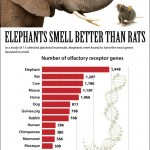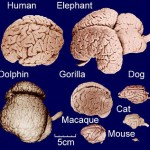elephant
Check out this new YouTube video describing a new study aimed at discovering how elephants resist developing cancer:
Sadly, the second herpes virus-related death occurred after this story was released at the Albuquerque BioPark. The victim was a five-year old Asian elephant named Daizy.
Source:
The Scientist
Like Aesop's fable, rats have another reason to be envious of elephants. Elephants also have significantly more genes that can detect different smells (i.e. olfactory receptor genes) than other super-sniffers like rats and dogs. In fact, compared to 13 other species, African elephants have 1,948 genes related to smell putting them ahead of the previous record holder, rats that only have about half as many genes. Primates have much fewer with only 296-396 of these olfactory receptor genes. Interestingly, the common ancestor of mammals had 781 olfactory genes, meaning that primates have lost…
Research published last month in PNAS provides evidence that African elephants (Loxodonta africana) can differentiate human voices. This is a very important skill to an animal that is often threatened by humans. Prior research has shown that elephants could tell the difference between African ethnic groups using sight and scent.
The study was conducted by Drs. Karen McComb and Graeme Shannon (University of Sussex, Brighton, UK). They recorded men from two different Kenyan ethnic groups speaking in their native language the phrase "Look, look over there, a group of elephants is coming." The…
Hair on an Asian elephant (right) compared to an African elephant's head (left). Image taken by: Conor Myhrvold
Researchers think that the hair on an elephant might actually function to keep the animals cool as opposed to keeping them warm as it does for other mammals. Living in hot climates (as high as 122 degrees F) since the last ice age means the animals have had to evolve ways to tolerate the heat. Until now, it was only known that elephants kept cool by dissipating heat from their ears (circulating warm blood to their large flat ears, where the heat could escape, and returning…
Given the recent elephant hunting scandal, I thought I'd repost this award-winning piece from the archives, on a very clever way to deter elephants from raiding human settlements. Much cleverer than shooting them. (Click on the archives icon for the original.)
What information is contained in the call of a mammal? Some calls might reflect the internal emotional state of the animal, like fear or anxiety, or they can refer to an external object, agent, or event, like the presence of a predator. Rhesus monkeys, lemurs, baboons, and guinea pigs, for example, will produce calls when separated from…
I was reading Christie's excellent post (and you should too) on GoDaddy CEO Bob Parsons' elephant killing incident (is it too early to be calling this #ElephantGate?)
Although I don't know quite enough about what is going on in Zimbabwe, I tend to err on the side of not intentionally killing elephants because - as I argued for the case of chimpanzees - they are very likely self-aware.
I wrote:
There is another important cognitive capacity that unites animals with high encephalization quotients (the ratio of brain to body size - I recommend going back to read my earlier post for the context…
This amazingly clear 3D ultrasound image of an elephant fetus was taken just three months into its 22-month-long gestation period. The little guy, now named George, was born nineteen months later at ZSL's Whipsnade Zoo.
You can even see his little trunk and everything!
(h/t Metro UK)
This one is worth watching all the way through:
(h/t Sara)
And, from the sublime to the mundane:
(h/t Dr. Kiki)
The National Institutes of Health announced that by 2011 it will transfer almost two hundred chimpanzees from the Alamogordo Primate Facility in New Mexico to a lab in San Antonio, Texas, lab for use in invasive research. In 1995, the NIH announced a moratorium on the breeding of chimps in federally-supported labs, and as a result, scientists have developed alternative ways to investigate diseases. But there are still viruses, such as hepatitis C and HIV, that other species simply can't contract. This fact, some argue, makes it prudent to subject chimps to this sort of biomedical testing.…
A McDonald's ad from the Netherlands envisions what might have happened if Pleistocene humans had the option of visiting the drive-thru instead of going after fresh mammoth steak.
Image via Discovery Press Web.
In his monumental 1945 monograph on mammal classification, paleontologist G.G. Simpson appraised the living species of elephants to be "relicts of a dying group." The living African (Loxodonta) and Asian (Elephas) elephants were all that remained of the past diversity of proboscideans, and human activities put even these large mammals at risk of extinction. Poaching and human development on land bordering game preserves continue to put elephants at risk, and the two-hour BBC special The Secret Life of Elephants, airing this Sunday on Animal Planet in the US,…
What information is contained in the call of a mammal? Some calls might reflect the internal emotional state of the animal, like fear or anxiety, or they can refer to an external object, agent, or event, like the presence of a predator. Rhesus monkeys, lemurs, baboons, and guinea pigs, for example, will produce calls when separated from their conspecifics or in the presence of a stranger. Howler monkeys produce specific alarm calls for avian predators, even when they have never encountered an avian predator for several generations. Vervet monkeys produce different calls in response to…
For much of the past 130 million years South America was an island continent, and on it organisms evolved in "splendid isolation." Mammals, especially, evolved into forms not seen anywhere else, and while some mammalian immigrants made their way to South America during the past 30 million years it was not until about three million years ago, with the closing of the isthmus of Panama, that large animals from North and South America began to wander across the new landbridge and mix with the endemic faunas. This is why there were elephants in South America and giant ground sloths in North…
Dave Goldenberg of Gelf Magazine was kind enough to send along this very graphic, often upsetting, but ultimately pretty awesome video of a baby elephant birth in Indonesia. Watch to the end.
At first glance, the African elephant doesn't look like it has much in common with us humans. We support around 70-80 kg of weight on two legs, while it carries around four to six tonnes on four. We grasp objects with opposable thumbs, while it uses its trunk. We need axes and chainsaws to knock down a tree, but it can just use its head. Yet among these differences, there is common ground. We're both long-lived animals with rich social lives. And we have very, very large brains (well, mostly).
But all that intelligence doesn't come cheaply. Large brains are gas-guzzling organs and they need…
This is a bull elephant firmly establishing why it is he, and not the lion, who is king of beasts. The elephant's penis is not only massive but prehensile. As we watched in baffled amusement (and the faintest tinge of inadequacy), he used his penis to prop himself up (as in the photo), swat flies from his side and scratch himself on his stomach. David Attenborough never showed us that...
There's good reason for elephants to have prehensile penises. It's hard enough for a six-tonne animal to get into the right position for sex, let alone having to do the rhythmic thrusting that's required. So…
Get out your Kleenex, wimps.
Thanks, Berkery for forwarding this along.
A form of deadly herpes is sweeping through American zoos, killing 1 in 5 Asian elephant calves born in the U.S. since 2000 according to a recent article in the New York Times.
It's about suppression.
Researchers and zookeepers know almost nothing about the elephant endotheliotropic herpesvirus including how it is spread, which elephants carry it, how to treat it or why it seems to kill only baby elephants. They have, however, begun to recognize some of the myriad symptoms: sluggishness, loss of appetite, swollen heads and pale, bruised tongues. From the time the symptoms are noticed, the…
As reported in the NY Times and elsewhere, an auction of 108 metric tons of ivory took place today in Namibia, Botswana, Zimbabwe and South Africa. The buyers were exclusively from China and Japan. Not surprisingly, this sale has raised the ire of animal welfare groups, such as the International Fund for Animal Welfare (IFAW).
You might be surprised to learn however that this was a legal auction sanctioned, and in fact run, by CITES, the Convention on International Trade in Endangered Species of Wild Fauna and Flora. So here are the facts:
* All of the ivory sold comes from government…





